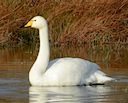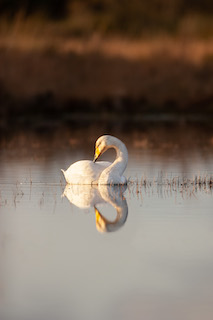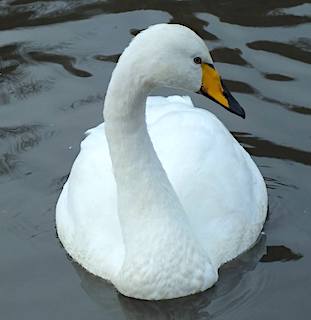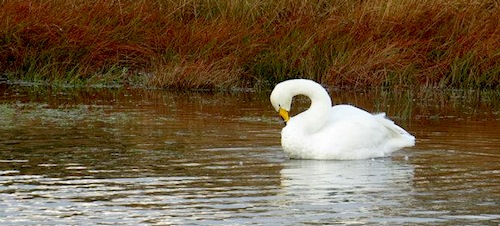 Overwintering and migrating Whooper Swans can be spotted on The Lizard’s inland pools in autumn and winter.
Overwintering and migrating Whooper Swans can be spotted on The Lizard’s inland pools in autumn and winter.
Photo: Steve Townsend
Scientific name: Cygnus cygnus
Other common names: Elk (now obsolete)
Cornish name: Alargh is the general word for swan
Conservation status: UK Birds of Conservation Concern, Amber; IUCN Red List, Least Concern; listed as a Species of European Conservation Concern
What to look for:
- Colouring and appearance: Large swan, black bill with large yellow triangular-shaped patch, black legs. It usually holds its neck erect when on the water. Juveniles are grey-brown, and their bill is pink and black.
- Size: Length 140 to 160 cm, wingspan 205 to 235 cm.
- Where: Winter visitor or passage migrant. Found on estuaries and wetlands.
- Call: Loud deep honking
- Similar species: Bewick’s Swan, another winter visitor, which is smaller (it is similar in size to a Canada Goose). The yellow patch on a Bewick’s Swan’s bill is more rounded than the triangular patch on a Whooper Swan.
 Throughout the summer, the call of the Whooper Swan can be heard bugling across the tundra wetlands of subarctic Eurasia. They are noisy during their courtship display, when pairs face each other, wings held partly lifted, bobbing their head and neck up and down. Each pair (they mate for life) works together during the breeding season: both birds share nest-building duties, and the male guards the female while she incubates the clutch of three to seven eggs. After hatching, the cygnets take almost 90 days to fledge fully, in preparation for following their parents on the southward migration.
Throughout the summer, the call of the Whooper Swan can be heard bugling across the tundra wetlands of subarctic Eurasia. They are noisy during their courtship display, when pairs face each other, wings held partly lifted, bobbing their head and neck up and down. Each pair (they mate for life) works together during the breeding season: both birds share nest-building duties, and the male guards the female while she incubates the clutch of three to seven eggs. After hatching, the cygnets take almost 90 days to fledge fully, in preparation for following their parents on the southward migration.
As winter arrives, the swans migrate further south; here in the UK the Whooper Swans we welcome to our shores have mostly flown from Iceland. Most overwinter in the north of Britain, but individuals and small groups can be spotted further south. They are strong fliers, and can reach high altitudes on migration, often flying thousands of miles.
 Their diet mainly consists of aquatic vegetation, but they will also graze on land. The Whooper Swan is a scarce breeder in the UK, with a very small number of pairs breeding in northern Scotland, especially Orkney and Shetland. This small breeding population, together with the importance of the overwintering population, is the reason for the Whooper Swan’s Amber status in the UK.
Their diet mainly consists of aquatic vegetation, but they will also graze on land. The Whooper Swan is a scarce breeder in the UK, with a very small number of pairs breeding in northern Scotland, especially Orkney and Shetland. This small breeding population, together with the importance of the overwintering population, is the reason for the Whooper Swan’s Amber status in the UK.
Did you know…?
…On land, a Whooper Swan’s legs can only support its body weight for short periods of time. This is why it spends most of its time swimming on the water.
…An aeroplane pilot once spotted a flock of Whooper Swans flying at an altitude of over 8000 feet.
More information and references:
Svensson, L., Mullarney, K., Zetterstrom, D.,1986. Collins Bird Guide, second edition (translated by Christie, D., Svensson, L.). HarperCollins, London.
Published: November 2014
Author: Amanda Scott
Photos: Upper – © Richard Birchett; middle – Amanda Scott; below – Steve Townsend

